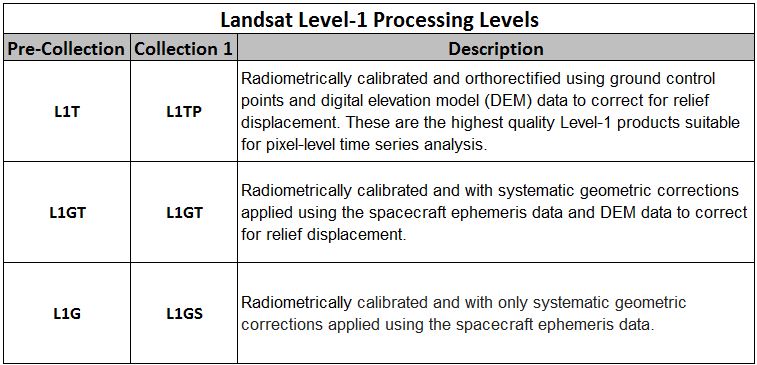Landsat Raw Data

These images are compressed versions of high definition television (HDTV) images showing how Landsat data, which spans a very broad swatch of the electromagnetic spectrum, can be turned into images. The TIFF versions of these images are full resolution HDTV frames (1920 x 1080).
All images have the HDTV standard aspect ratio (16:9). The Thematic Mapper (TM) on Landsat 4 and 5 observes reflected sunlight from the Earth all the way from blue in the visible part of the electromagnetic spectrum to shortwave infrared well beyond the ability of the human eye to percieve.
The TM instrument also can observe infrared radiation actively emitted by the Earth from thermal infrared radiation. Landsat 7 carries an improved version of the TM instrument, called ETM+. In addition to 7 channels of spectral data collected by the older TM instruments, ETM+ can observe in a special panchromatic band spanning the entire visible spectrum at twice the resolution of the TM bands (15 meter resolution instead of 30 meters). The ETM+ also has a major improvement in the resolution of the thermal band (60 meter resolution instead of 160 meters). A standard way to create images from raw Landsat TM and ETM+ data is to display a single band as a primary color, then combine different bands to create a full color image.
USGS EROS Center. Landsat Archive. • ~ 625 TB Raw and L0Ra Data. • The USGS will maintain the national archive of Landsat data, distribute data to. Earth Engine makes this data available in its raw. In addition to raw Landsat thermal data. Atmospheric datasets such as ozone data from NASA's TOMS and OMI.
Spore Hack Editor V2 Software. Images shown here demonstrate combining three bands to make a color image using TM bands 5, 4, and 2, which covers a very broad range of the TM's spectral coverage. It is also shown in combination with a digital elevation model. Terrain data is shown with vertical features exaggerated by a factor of three to emphasize details.
Landsat Algorithms. To convert raw Landsat data to surface reflectance. Sign up for the Google Developers newsletter. Sahasa Veerudu Sagara Kanya Songs. Landsat represents the world's longest continuously acquired collection of space-based moderate-resolution land remote sensing data.
Note: An animation showing the spectral frequencies measured by Landsat, followed by illustrations of specific spectral band combinations applied to imagery of the San Francisco bay area. Animator: Jesse Allen (Raytheon). Scientist: Darrel Williams (NASA/GSFC). Platforms/Sensors/Data Sets: Landsat-5/TM, DTED Level 1 (3 arc second).
Landsat 7 before launch Mission type Earth imaging Operator / 25682 Mission duration Elapsed: 18 years, 9 months and 27 days Spacecraft properties TIROS-N Manufacturer Dry mass 2,200 kilograms (4,900 lb) Power 1550 W Start of mission Launch date 15 April 1999, 18:32:00 ( 1999-04-15UTC18:32Z) UTC Rocket Launch site Contractor Orbital parameters Reference system Regime 701 kilometers (436 mi) 703 kilometers (437 mi) 98.2126 degrees 98.83 minutes 234.2660 degrees 78.1806 degrees 281.9541 degrees 4 Repeat interval 16 days 11 June 2016, 18:59:03 UTC Landsat 7 is the seventh satellite of the. Launched on April 15, 1999, Landsat 7's primary goal is to refresh the global archive of satellite photos, providing up-to-date and cloud-free images. The Landsat Program is managed and operated by the, and data from Landsat 7 is collected and distributed by the USGS. The project allows 3D images from Landsat 7 and other sources to be freely navigated and viewed from any angle.
The satellite's companion,, trailed by one minute and followed the same orbital characteristics, but in 2011 its fuel was depleted and EO-1's orbit began to degrade. Landsat 7 was built by Lockheed Martin Space Systems Company. In 2016, NASA announced plans to attempt the first ever refueling of a live satellite by refueling Landsat 7 in 2020. The effect of the SLC on ETM+ scans. Landsat 7 was designed to last for five years, and has the capacity to collect and transmit up to 532 images per day. It is in a,, meaning it scans across the entire earth's surface. With an altitude of 705 kilometers +/- 5 kilometers, it takes 232 orbits, or 16 days, to do so.
The satellite weighs 1973 kg, is 4.04 m long, and 2.74 m in diameter. Unlike its predecessors, Landsat 7 has a solid state memory of 378 gigabits (roughly 100 images). The main instrument on board Landsat 7 is the Enhanced Thematic Mapper Plus (ETM+).
Main features [ ] • A panchromatic band with '15 m (49 ft)' spatial resolution (band 8) • (reflected light) bands in the spectrum of blue, green, red, near-infrared (NIR), and mid-infrared (MIR) with 30 m (98 ft) spatial resolution (bands 1-5, 7) • A thermal channel with 60 m spatial resolution (band 6) • Full aperture, 5% absolute calibration Scan Line Corrector failure [ ] On May 31, 2003 the Scan Line Corrector (SLC) in the ETM+ instrument failed. The SLC consists of a pair of small mirrors that rotate about an axis in tandem with the motion of the main ETM+ scan mirror. The purpose of the SLC is to compensate for the forward motion (along-track) of the spacecraft so that the resulting scans are aligned parallel to each other. Without the effects of the SLC, the instrument images the Earth in a 'zig-zag' fashion, resulting in some areas that are imaged twice and others that are not imaged at all. The net effect is that approximately 22% of the data in a Landsat 7 scene is missing when acquired without a functional SLC.